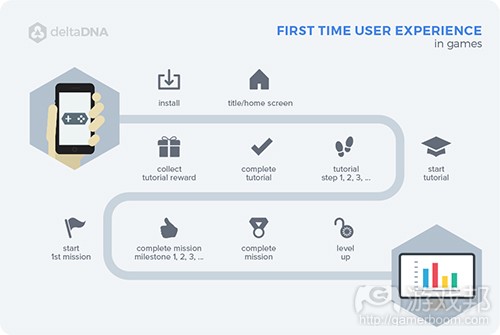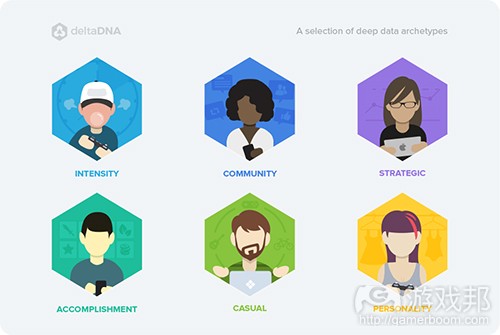免费游戏使用深度数据时需要做的三件事
作者:Mark Robinson
如今免费游戏市场中的“富人”和“穷人”间的差距达到了最大。DeltaDNA的数据也证实了这一点:排行前20%的游戏所拥有的付费玩家比例是4%,而排行末尾的游戏所拥有的付费玩家比例则不到0.5%。如今每个月全球共有13185款全新游戏面向iOS发行(根据Priori Data),以及22905款游戏在Android上发行,这里的竞争真的非常激烈。很多游戏逐渐转向使用深度数据分析去突显自己的游戏,完善玩家体验并创造真正的商业成功。但是具体该怎么做呢?
深度数据能够帮助你收集到每个玩家在游戏中任何点上的详细信息。就像在一款第一人称射击游戏中,你需要了解玩家的杀戮,所创造的伤害以及所遭到的伤害,使用的武器,进程,死亡,使用的药剂,重新复苏的次数,经验值,游戏内部货币,所加入的小组等等。
我们总是拥有无限的机遇去创造可行动的想法。而在一开始,关于深度数据主要存在三大要点能够帮助我们完善自己的免费游戏。
1.明确全新玩家会在哪里以及为什么会离开
用户留存是免费游戏中的关键参数,平均有20%至30%的玩家会在游戏的前2分钟内离开。所以追踪用户初体验(FTUE)将帮助你更好地完善玩家的游戏进程。在这里小小的改变都有可能为你后来的游戏创造出很大的不同。
你需要明确是哪部分内容导致玩家的离去。也许游戏控制未进行详细解释,或者太消耗时间了。为了做到这点你需要比较那些离开游戏的玩家与继续留在游戏中的玩家的体验。
实际做法
在你的游戏分析平台上设置一个精确的事件计数器能够帮助你更好地追踪玩家的FTUE。
接下来你可以使用漏斗去分析玩家的关卡进程,如此你便能够了解游戏的哪个部分是阻碍玩家前进的罪魁祸首。
让我们着眼于每个游戏关卡的用户留存和盈利数据并识别一些关键数值(游戏邦注:例如大多数玩家会在第5个关卡花钱,或者游戏的用户留存高峰出现在第3个关卡)。
最后,通过比较现实世界时间和游戏内部进程,你便可以通过平衡游戏以避免玩家失去游戏动力。
2.进行除鲸鱼玩家和grinders玩家外的划分
游戏开发者总是会基于某种方式去划分玩家以帮助自己制定市场营销策略。在免费游戏中通常会有一些较常见的划分方式。如鲸鱼玩家(花费最多的玩家),新手玩家,资深玩家以及Grinders等便是最常出现于游戏分析中的术语。但尽管这些玩家划分很有帮助,如果你只是依赖于这样的划分,你便可能忽视那些只面向你的游戏的群体以及它们的构成方式。
基于深度数据,你可以进一步着眼于像用户粘性,玩家表现,进攻,策略,社交或任何其它游戏元素而进行划分。通过明确你自己的划分,你可以使用玩家用户粘性工具去创造更强大的体验。例如可以通过发信息,送礼物等方式做到这点,或在必要的时候调整游戏参数。这么做的目标是让所有玩家都会觉得玩家既有挑战性也有奖励性。
实际做法
明确你自己的玩家划分的第一步便是考虑你该使用怎样的测量方式。例如着眼于玩家的经验值和杀戮/死亡率,如此你便可以划分出最厉害的玩家。然后你可以测量他们的游戏互动,并因此带进用户粘性机制和实时测试。
3.从每个角度进行测试
与划分玩家同样重要的便是衡量任何互动或挑战的即时和长期效果。A/B测试便是最常用的一种方式。
A/B测试经常被用于为各种玩家创造适宜的标准,如IAP定价。它可以呈现出你所提供的内容是否得到用户的认可,并让你看到玩家的进程和盈利。简单来说就是,做出游戏改变可能会让一部分玩家花更多钱于游戏中而让另一部分玩家花更少钱。所以你应该使用各种游戏仪表盘工具并从每个角度去衡量结果。
实际做法
决定你想要在测试中使用的变量数,并瞄准特定的用户群体。
像deltaDNA的A/ B测试等高级工具也能够让你访问一些重要的测试和分析仪表盘,所以你便能够明确不同变量在游戏不同部分的效果。
使用深度数据去优化你的游戏
使用深度数据能够帮助明确玩家如何与你的游戏进行互动并让你了解哪些人才是你的玩家。你需要使用这些信息与玩家更有效地联系在一起,否则你的努力将只会白费。如果你能够专注于优化面向所有玩家的游戏体验,你便有可能获得真正的商业成功。
(本文为游戏邦/gamerboom.com编译,拒绝任何不保留版权的转发,如需转载请联系:游戏邦)
3 things every F2P game should be doing with deep data
by Mark Robinson
The gap between the ‘haves’ and the ‘have-nots’ in the F2P games market has never been greater. DeltaDNA data confirms this: the top 20% of games have a payer fraction of more than 4%, while the lowest have less than 0.5%. And with 13,185 new iOS games released globally each month (on average, according to Priori Data), and 22,905 on Android, competition is tough. Many are turning to deep data analytics to differentiate their games, improve player experience and create a commercial success. But how exactly do you do this?
What deep data provides is the ability to gather detailed information on each player at any point in the game. So, in a First Person Shooter game, knowing kills, damage inflicted and received, weapons used, rate of progress, deaths, potions used, re-spawns, experience points, in-game currency, squads joined… the list goes on.
The opportunities to generate actionable insight are endless. To get started, here are three essential things to do with deep data that will help improve your F2P game.
1. Determining where & why new players are leaving
Retention is a key metric in F2P games, and on average 20%-30% of players leave within the first two minutes of game play. Tracking the First Time User Experience (FTUE) will help you to improve the onboarding process. Small improvements here can make a big difference later on in your game.
A typical FTUE journey in a F2P game
You need to determine which aspects of your onboarding are causing segments of players to leave. Perhaps the controls aren’t clearly explained, or it’s too time-consuming. To do this you need to compare the experience of those players who left with those who stayed.
Practical steps
On your game analytics platform, set a high density of event counters to enable you to track how players are moving through the FTUE.
Next, use funnels to analyze level progression, to instantly tell you which areas of the game are acting as blockers.
Look at retention and monetization statistics at each game level to allow key thresholds to be identified (e.g. most players pay at level 5, or retention peaks at level 3).
Finally, by comparing real-world time to in-game progress, the game can be balanced to ensure that players never lose momentum and churn.
2. Segmenting players beyond whales and grinders
Game developers have always segmented players in one way or another to help with marketing strategies. In F2P, this has led to a number of commonly identified segments which describe shared player behaviors. Whales (big spenders), Novices, Experts, and Grinders have become commonly used terms in game analysis. But while these player segments are useful, if you rely on them alone, you could overlook segments that are unique to your game and the way it’s structured.
Identify unique segments by looking at shared player behaviors in your game
With deep data, you can take a more detailed look at factors like engagement, player performance, aggression, strategy and social interaction, or any aspect of gameplay to create a segment. By identifying your own segments, you can then use player engagement tools to create augmented experiences. For example, this could be implemented through messaging, gifting and making offers to individual segments, or adjusting game parameters when needed. The objective is for the game to both challenge and reward all players.
Practical steps
The first step in defining your own unique player segments is to consider which measures you will use. For example, looking at the rate XP is gained alongside kill/death ratio could identify a segment of highly competent players. You’re then all set to measure their game interaction, introduce engagement mechanics and live testing.
3. Testing from every angle
Just as important as identifying segments is to measure both the immediate and long term effects of any campaigns or adjustments made. A/B testing is most widely used by developers to do this.
A/B testing is often used to establish optimum levels for variants, e.g. IAP pricing. It can show whether an offer is being well received, and show the implications for player progression and monetization. To put simply, making a change to the game may cause one group of players to spend more and another to spend less. So, you need to evaluate the results from every angle using a broad variety of game Dashboard tools.
Practical steps
Determine the number of variants you want to set up in your test, and target specific user segments.
A/B testing can be used to test different variables, including in-game messaging and offers
An advanced tool like deltaDNA’s A/B Testing will also give you access to significance testing and analysis dashboards, so you can ascertain the effects of each variant on all aspects of your game.
Optimizing your game with deep data
Access to deep data is essential for determining how players interact with your game and for knowing who your players are. You need this information to engage with your players effectively, otherwise you risk upsetting as many as you encourage. Focus on optimizing the experience for all players and you’ll find commercial success is far more likely to follow.(source:gamasutra)
上一篇:如何创造一款成功的手机模拟游戏










































 闽公网安备35020302001549号
闽公网安备35020302001549号